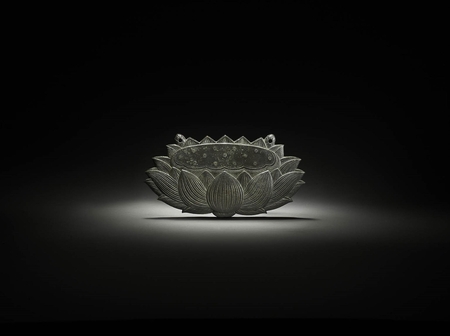Product Description
6905 A bronze kei (ritual chime) in the form of a renge (lotus blossom).
Japan 14th/15th century Kamakura/Muromachi period
Fitted box inscribed: Kamakura jidai renge bun kei (Kamakura period lotus blossom-design chime).
Dimensions: H. 3½” x W. 7″ (9cm x 18cm)
The first chimes produced in Japan in the early Heian period were of simple, geometric, chevron or lozenge form, with the only ornamentation a raised central boss which was struck with a wooden mallet. From the 12th century onward the dominant form of kei was a scallop-edged chevron shape with peacocks on either side of the boss. It was not until the late Heian/early Kamakura period that metal workers began to create chimes with more varied inventive forms and ornate surface decoration.
From the late 12th century chimes began to be decorated with various motifs such as floral arabesques, lotuses, pagodas and long-tailed birds, whilst other kei were cast in the form of clouds or butterflies. It was extremely rare, however, for chimes to be cast in the form of a lotus and there are very few known existing examples of this type.
The symbolism of the hasu (lotus) has its roots in the Buddhist traditions of India and China, later transmitted to Japan, and is considered a sacred flower and a symbol of purity. The lotus blossom serves as a metaphor for the attainment of enlightenment in the mundane world. Carved, painted, embroidered, and worked in metal, the flowers are ubiquitous symbols in Buddhist temples, and many Buddhist deities are traditionally shown seated or standing on lotus bases.
The lotus symbolises the cycle of life but is also linked with the rituals of death, for it is associated with transformation in the Buddhist heaven where new souls in paradise are said to appear seated on lotus blooms. It also holds many other auspicious meanings including harmony, love, sympathy and prosperity.
For a similar example of a Kamakura period kei in the form of a lotus blossom see: ‘Object as Insight: Japanese Buddhist Art and Ritual’, 1995, Katonah Museum of Art, p.43.
Similar lotus blossom-shaped chimes from the Kamakura period are held in the collections of: The Museum of Fine Arts, Boston; The Hosomi Museum, Kyoto; Sekishō-in Temple, Mt. Koya, Wakayama prefecture, Japan.





